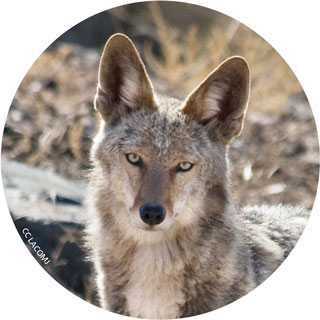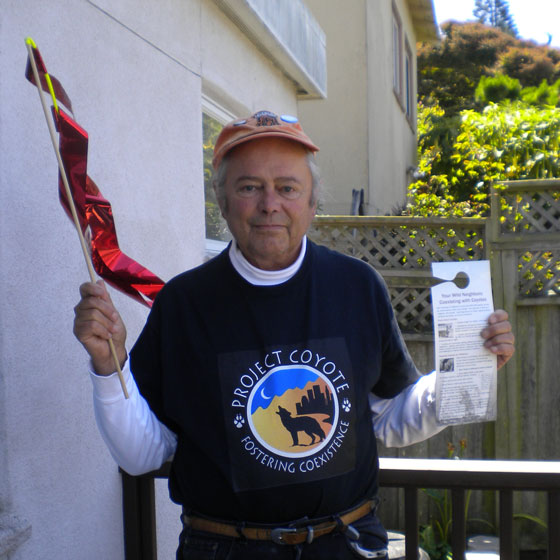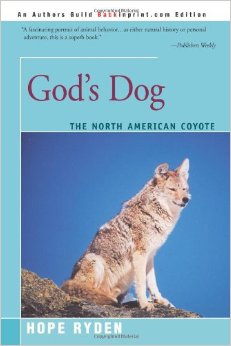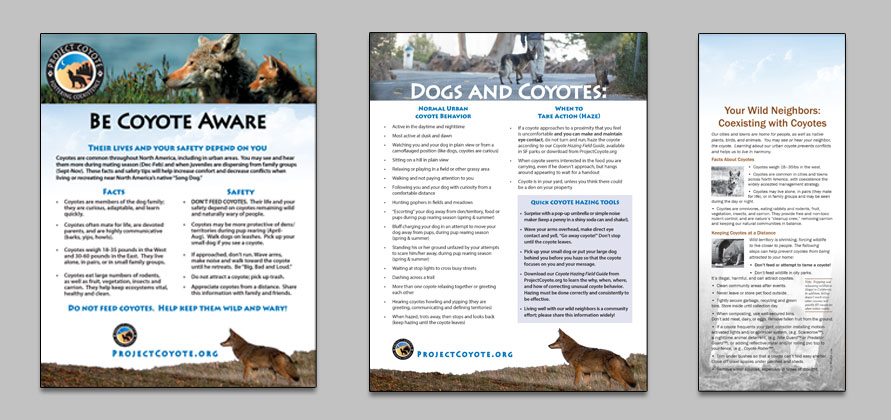Coyote Friendly Communities: Meet Citizen Dan
I’m not only advocating for coyotes, I’m advocating for humanity.
Dan became a Project Coyote Citizen Leader in the early spring of 2016, after meeting Project Coyote’s Founder and Executive Director Camilla Fox at a conference in San Francisco. He has since collaborated on a mapping tool that shows where he has distributed information and connected with people. He regularly submits reports of his outreach to Project Coyote and San Francisco’s Animal Care and Control (AC&C). He has been quietly pioneering a practice that many citizens who care about wildlife may be interested in emulating. With that in mind, we recently caught up with Dan to learn more about his background and experiences educating members of his community about coyotes and other wildlife.
“I went out on coyote walkabout again today….I talked to a woman who wasn’t so much hostile as fearful. She said she wasn’t going out in the dark any more. I showed her the little red AC&C flasher and she asked “how much?” I explained that I was giving them away and she asked for another for her husband.” – Report Excerpt by Dan De Vries
If you find yourself inspired to become a Citizen Leader in your community, we encourage you to visit Project Coyote’s website, get involved, check out our downloadable resources, and learn more about the purpose and impact of our Community Friendly Communities program.
A Conversation With Dan De Vries: Project Coyote’s First Citizen Leader
By far most people in this particular neighborhood are grateful for information and want to coexist, not only with coyotes but with all the life – animal, plant, and human – around them.
Q: Dan, you have pioneered a new role in your San Francisco community, educating people about to ways to live peacefully with coyotes. Where did this interest come from?
My parents, to their credit, supported my interest in natural history, including frequent visits to the Grand Rapids Public Museum, which had a pretty amazing hall of dioramas of North American mammals, and the skeleton of a Mastodon of Midwestern ancestry.
After graduating college I lived in Laramie, Wyoming, which turned out to be a clear window to the outdoors. It was often cold, remarkably clear when the snow wasn’t falling, and has three different mountain ranges surrounding it. You can see the peaks in Rocky Mountain National Park to the south.
In those days there was one bumper sticker frequently on the pickup trucks with gun racks there. It read: Eat More Lamb: 10,000 Coyotes Can’t Be Wrong! It was pretty clear what that was all about, and I wasn’t so certain I agreed.
A year later I found myself in Vancouver, BC and, ended up on a tree-planting contract on a remote island between Vancouver Island and the mainland. That was really the beginning of my awareness of environmental issues.
We could hear the most amazing wild canid songs at night. I first assumed it was coyotes, but the next morning those who knew assured me it was wolves.
On that remote island, we could hear the most amazing wild canid songs at night. I first assumed it was coyotes, but the next morning those who knew assured me it was wolves. That has to be my first romantic infatuation with wild canids. By the time I ended up in the Bay Area that infatuation had matured into fascination, and was focused on coyotes here.
Above Photo: Golden Coyote by Danielle (Creative Commons 2.0 BY NC ND)
I planted trees in BC for three seasons, and the last of those I ended up on a contract on the Fraser River in the interior. The contractor had pulled a Sheltie mix out of the Prince George pound as a bear dog and he was going to send her right back to the pound when she had served his purpose. The lady I was traveling with (we married not long afterward), would have none of that, so we snuck her through the border instead on our way to the Bay Area where my soon-to-be wife was from. The more we learned about coyote behavior, it struck us that Mountain Dogwood (named for BC’s Provincial flower) had some song dog in her. So that increased my interest in coyotes. Reading Hope Ryden’s book God’s Dog around the same time was important too.
Also, as a reader, I encountered Native American traditions involving the Coyote as a myth and character, and poets such as Gary Snyder or Barry Lopez who also brought the coyote alive in their work. So some combination of compelling natural history, legend, and literary reference, has fueled my affection for coyotes.
My first personal encounter with a coyote was on a trail in a San Mateo County Park in the Coast Range in the early 1980s. I loved the bright inquiring eyes and those eager-to-hear ears.
Q: How did you find out about Project Coyote and the Coyote Friendly Communities program, and what interested you about it?
Since moving to San Francisco proper in the early 1990s, I’ve played golf at Lincoln Park Golf Course. Around the year 2000, when coyotes first started being noticed in the city, we would see them on the golf course. They would trot right across the fairways without getting particularly close to people, but pretty clearly not too worried about us golfers. Ten years later, after I retired, I marshalled at Lincoln, and I would often see them at a particular spot on the course, just lounging in the fairway if no one was playing that hole. We’d also hear family yips from a thicket quite near that part of the course.
Above Photo: Coyote on golf course by Mike (Creative Commons 2.0 BY NC ND)
Around that time, State Assemblywoman Fiona Ma held a couple of public meetings to address public concerns about urban coyotes. I went to one of them in the Richmond district. I happened to sit next to Project Coyote’s Founder and Executive Director Camilla Fox, not knowing anything about her or Project Coyote. Camilla was not on the agenda, but some of those who were on it addressed and acknowledged her from time to time. It was pretty clear Camilla commanded special respect in that room. I chatted briefly with her after the meeting and that’s how I first learned about Project Coyote.
Q: What is a CFC Citizen Leader, and what do you do?
Right now, as a Citizen Leader, I canvas a San Francisco neighborhood known as Ingleside Terraces, which is a couple of blocks from my own home. It’s east of Junipero Serra Boulevard near San Francisco State and Stern Grove in the southwest corner of the city.
I carry door-hangers developed by Project Coyote and endorsed by San Francisco Animal Care & Control, the San Francisco Recreation and Parks Department, and SF Dog (San Francisco Dog Owners Group). If no one comes to the door, I simply leave it on the door. If someone does come to the door I explain that I am passing out information on the coyotes that “visit” the neighborhood, and answer questions if they have them. When I hear dogs, or see a “Beware” sign, I also leave Project Coyote’s flyer on Dogs and Coyotes (endorsed by the same three other groups) at the house.
I also have sample hazing sticks with red mylar ribbon to wave at a coyote, and enough red flashers to give to anyone who wants them.
I also printed out a Google map of Ingleside Terraces, and when I complete an area I highlight the route and email it to Project Coyote and SF Animal Care & Control. AC&C has a master map online that notes the streets people have canvased as I just described.
There have been frequent coyote sightings in the neighborhood at all different times of day and night, everything from seeing them just trotting along to lolling in the drought gardens that a lot of residents have landscaped. Sadly, there have been a couple of instances where people appear to have lost cats to them. Mostly, though, the encounters have not been threatening, and some people I have talked with profess to actually like having the coyotes come visit. I don’t particularly encourage that attitude, but it’s kind of reassuring that some people feel that way.
Some people I have talked with profess to actually like having the coyotes come visit.
Q: What have you learned about people and wildlife from being a CFC Citizen Leader?
More about people than coyotes, for sure.
As far as the coyotes go, from talking to people who have seen them in Ingleside Terraces, I’ve learned that they are seen quite frequently, and are in general pretty well-behaved. Almost too well-behaved. Project Coyote’s insistence, to which I fully subscribe, is that wildlife, and coyotes in particular, should not feel too comfortable in urban neighborhoods. The coyotes visiting Ingleside Terraces may be getting a little too comfortable there. I say “visiting” because I don’t think anyone has identified a den yet, although some of the wilder backyards (and there are some) could become habitat. Most people I’ve talked to seem to think these coyotes are exploring from Stern Grove where we know there are dens. It’s not much more than a mile overland, so well within their range.
Of the people I have talked to, and it’s certainly more than 100 by now, I have only encountered two who were hostile to coyotes, and no more than five who are fearful of them. I have had great conversations with the fearful individuals. They want to be reassured, and are grateful for the information on the door hanger. I also give them a red flasher provided by SF Animal Care & Control, and a couple took hazing sticks.
The rest of those I talk to range from accepting a coyote presence, to a significant number, at least one in four or five, who like having coyotes in their neighborhood. Of those, about half express some understanding of the ecological benefits coyotes can bring to even an urban environment. The other half, remarkably, just think having coyotes in their neighborhood is cool. I’ve come to think of it as a kind of Bambi effect. Not such a stretch when you consider that most people adore deer, even though deer do a lot more damage to environments cultivated by people than coyotes possibly could, to say nothing of their unfortunate habit of colliding with motor vehicles.
Ingleside Terraces has 750 homes, and I estimate I’ve covered about three-quarters of it by now. Even talking to someone in only every fourth home, I’ve by now had conversations with quite a number of residents there.
So what I’m learning about people is that there is a great deal more good will out there than one might think. Public meetings and forums such as Nextdoor tend to bring out angry folk with personal axes to grind, but people as a whole are more informed, thoughtful, and compassionate than not.
Not to state it too grandly, but I really believe that survival of large predator species is critical to global species diversity.
Q: What has been your favorite moment so far? Most surprising?
Ingleside Terraces is on more even terrain than a lot of San Francisco, but some of the homes have serious steps up to the front porch. I get around on these walks with a cane (bad knees), and after chatting briefly with one man who came to his door, he said, “This must be pretty important to you, to climb all these stairs.”
And, of course, it is, and it was gratifying to have someone acknowledge that. Why is it important? Not to state it too grandly, but I really believe that survival of large predator species is critical to global species diversity. Global species diversity is essential to long-term human survival and is at terrible risk in the present time. So I’m not only advocating for coyotes, I’m advocating for humanity.
As to surprise, it’s not a particular moment, but the fact that people are as welcoming as they are is a bit of a surprise. People actually thank me, not as a pro forma courtesy, but express gratitude that someone is out providing information.
Q: What advice do you have for others who want to help protect wildlife in their community?
After you check out the bullet points on Project Coyote’s Easy Tips for Coexistence card, think about how this could apply to so many areas of life. If something is important to one, it is very satisfying to act on it in a manner that harmonizes with the rest of one’s life and values.
In my case, walking a neighborhood near mine for something such as coexistence with coyotes, creatures that I find seriously fascinating for a whole multitude of reasons, is good for my heart, both physically and spiritually.








